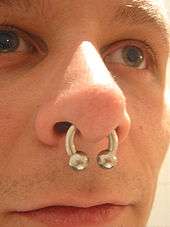Nose piercing
| Nose piercing | |
|---|---|
 | |
| Nicknames | Nose ring |
| Location | Nose (nostril, nasal septum, nose bridge) |
| Jewelry | nose stud, nose bone, Circular barbell, curved barbell, captive bead ring |
| Healing | 3 to 6 months |
Nose piercing is the piercing of the skin or cartilage which forms any part of the nose, normally for the purpose of wearing jewelry; among the different varieties of nose piercings, the nostril piercing is the most common. Nose piercing is the second most common varieties of piercing after earlobe piercing.
Nostril piercing
Nostril piercing is a tiny body piercing practice for the purpose of wearing elegant jewelry, much like nose piercing, which is most primarily and prominently associated with Indian culture and fashion since classical times, and found commonly in India, Bangladesh, Sri Lanka, Nepal and throughout South and even Southeast Asia. Nostril piercing is also part of traditional Australian Aboriginal culture.[1] With the diffusion, exposure and spread of Indian fashion and culture, nostril piercing has in recent decades become popular in the wider world, as have other forms of body piercing, after punks and subsequent youth cultures in the '80s and '90s adopted this sort of piercing. Today, nostril piercing is popular in the wider world including South America, United States of America, Canada, the Caribbean, Australia, Africa, Japan and Europe, with piercings being performed on either the left or right nostril.
Historically in the Indian Subcontinent, nose piercings are done by women only. However, since the spread of this fashion, inadequate and limited knowledge of the etiquette and styles in India, have resulted in sometimes both men and women having nostril piercings in the wider world, though they are much more common on women. Several different types of nostril rings are found. Among the most popular are the loop, the stud with an L-bar closure, the stud with a ball closure, and the stud with a flat backing.
In India the outside of the left part of the body [?] is the preferred position of the piercing. This practice supposedly makes childbirth easier. This is followed by some, also because Ayurvedic medicine associates this location with the female reproductive organs.[2] In India, like any other jewelry, piercings and the jewelry are regarded as a mark of beauty and social standing as well as a Hindu's honor to Parvati, the goddess of marriage. Nose piercing is still popular in India and the subcontinent. The piercings are often an integral part of Indian wedding jewelry. In Maharashtra women wear very large intricate nose pieces that often cover the mouth or the side of the face.
It is very common in Bengali women.Pashtun and Pahari women commonly have both nostrils pierced. Many South Indian Tamil also follow this old tradition. Numerous traditions are associated with it. One of which, for example, embraces the idea that the woman has her nose rings to pay for her funeral if she has all the gold taken from her. Nose rings or gold studs cannot be easily removed from the woman. Many women from the Asian subcontinent are cremated with just their nose studs as jewelry is removed before the funeral. Indian widows usually remove their nose studs as a sign of respect. Nose piercing has historically been strictly forbidden and is treated as a taboo among Kashmiri Muslims. This is an unusual practice in the context of South Asia as nose piercing is a common practice in the neighboring Muslim ethnic groups such as Pashtuns and Sindhis.
Nose piercing in society

Although occasionally seen earlier — the French actress Polaire arrived for her 1913 tour of America wearing a seed-pearl ring in her left nostril.[3] Only in the last two decades has nose piercing gained a mainstream popularity in American culture. Presently, it is the second most-popular body piercing desired by teens and young adults.
A 2007 study by career publisher Vault.com surveyed nearly 500 employees from across the United States and 87 percent believed having piercings or tattoos would not reduce their chance of being hired. Respondents explained:
"Regardless of who the real person may be, the stereotypes associated with piercings and tattoos are changing. In general, individuals with tattoos and body piercings are not being looked down upon as did in previous generations"
I see more and more people with piercings in business and everyday work settings. It's just a different generation," Says another employer.
Nose piercings in the workplace
More and more companies in the workplace have become more lenient on such issues as piercings and the dress code. [4]
The acceptance of more visible body modifications is attributable to its becoming a social norm. If companies did not hire employees with a tattoo or nose piercing, the number of future workers that the companies could hire would be limited.[5]
Septum piercing


The nasal septum is the cartilaginous dividing wall between the nostrils. Generally, the cartilage itself is not pierced, but rather the small gap between the cartilage and the bottom of the nose (sometimes called the "sweet spot"), typically at 14ga (1.6mm) although it is often stretched to a larger gauge (size). The nose has many nerves running through it, and as a result, nose piercings can be painful, although the pain varies by individual. This piercing heals within a month and a half to three months also depending on the individual. It should only be stretched by 1mm at a time, and waiting at least a month between stretches is advisable. If a certain point is exceeded, usually about 8mm, the cartilage gets forced towards the top of the nose, which can be uncomfortable.
Many types of jewelry generally are worn in a septum piercing, such as: Captive bead rings (CBRs), rings that close with a bead held in the center by the tension of the ring, circular barbells (as shown in the picture), a circular bar with a bead that screws onto either end, a "tusk" that is a straight or shaped piece of material generally tapered on either end, or pinchers. For large gauge septums, many individuals choose to wear plugs, as the plugs do not weigh their noses down, which is helpful in healing. This measure allows the piercing not to be damaged by the sudden movement of the jewelry.
Another option is a septum retainer, which is staple-shaped. This type of nose piercing is particularly easy to hide when desired, for example to comply with a dress code. A septum retainer makes possible turning the jewelry up into the nose, thus concealing it. With black jewelry flipped up into the nostrils, this piercing can be made practically invisible. A circular barbell can also be hidden by pushing it to the back into the nose, but it may be uncomfortable.
Septum piercing was a popular trend among South Indian dancers (Kuchipudi, Bharatnatyam) and among certain Native American peoples in history; the Shawnee leaders Tecumseh and Tenskwatawa, for example, had such piercings.
The septum piercing is popular in rural areas of India, Nepal, and Bangladesh. In India such piercing is called the 'Nathori' and popular with the Banjara ethnic groups and Adivasi tribes. Lord Krishna and his consort Radharani are often depicted wearing the 'Nathori' style jewel nose pieces.[6]
Bengali women traditionally would wear the nathori as a sign of being a married woman. The nathori would be gold with a tear drop that would move along the ring. Many lower-class women in rural Bengal still keep this tradition. This practice is now declining as many women prefer the nose studs.
In southern Nepal the septum piercing is still common. Many older women still adorn their noses with both the septum and left nostril rings. Many women have gold nose piercings to show their social, tribal, and religious status in society.
Risks
The septum or nasal septum is the cartilaginous wall that divides the two nostrils. The cartilage is, however, usually not pierced. It is the thin strip of very soft and flexible skin, just between the cartilage and the bottom of the nose, where septum piercing is mostly done. Piercing the skin instead of the cartilage can greatly minimize the pain, as well as other discomforts associated with this type of body piercing. This piercing should be done only with a needle. As far as jewelry is concerned, captive bead rings, circular barbells, plugs, tusks, curls, and septum retainer can be used.
All types of body piercings, including septum piercing, are associated with the risk of contracting certain blood borne diseases, like hepatitis, from the needles and piercing guns used in the procedure. This risk can be reduced by getting the piercing done by a reputed piercer and making sure that the piercer uses only sterile single-use needles. The next common risk associated with almost all types of piercing is the risk of infection and pain. These issues can be minimized greatly if piercing is done on the soft and flexible skin that lies between the cartilage and bottom of the nose. As far as infection risks are concerned, they can be managed with proper piercing aftercare.
This piercing can sometimes lead to 'septal hematoma' -- an injury to the soft tissue within the septum that can disrupt the blood vessels to cause the accumulation of blood and fluid under the lining. Nasal septum hematoma can eventually cause nasal congestion and interfere with breathing along with causing pain and inflammation. If not treated immediately, the condition can ultimately cause formation of a hole in the septum, leading to nasal congestion. Sometimes, that part of the nose may collapse, resulting in a cosmetic deformity, known as 'saddle nose'.
Bridge piercing

Bridge piercings are inserted through the skin at the top of the nose, between the eyes. Curved barbells and straight barbells are the most commonly used in this piercing, while seamless rings are less common.
See also
| Wikimedia Commons has media related to Nose piercings. |
Notes
- ↑ (Stirn 2003)
- ↑ Morris, Desmond (2004). "The Nose". The Naked Woman. p. 69. ISBN 9780099453581.
- ↑ New York Times, September 21, 1913
- ↑ Joyce, Amy. "Fashion Leads by a Nose." The Washington Post. (2013) Website.
- ↑ Dobosh, Sara. "Piercing the Workplace Stereotype." Fox Business. (2010) Website.
- ↑ "Septum Piercing Dangers". Retrieved 17 November 2012.
References
- Stirn, A. (2003). Body Piercing: Medical Consequences and Psychological Motivations. The Lancet 361: 1205–1215.